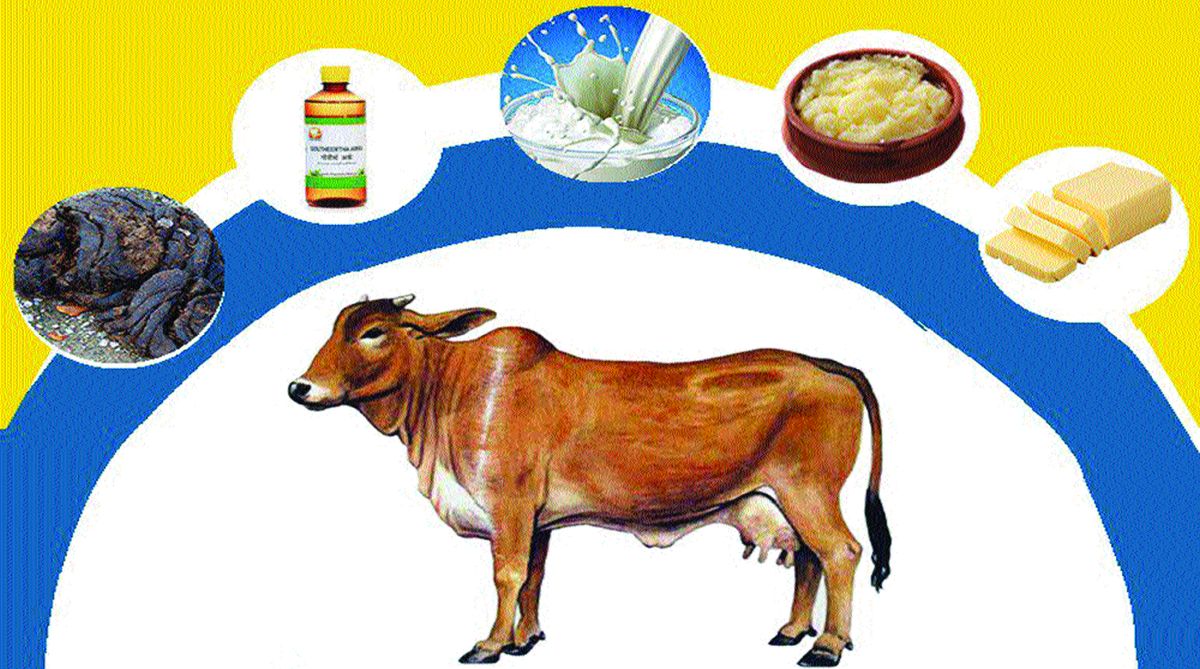In an earlier article I talked about the miraculous effects of Panchgavya on crops. Dr K. Natarajan, who has written the book after years of experimenting with it, has also written a chapter on its effects on animals. After the studies on plants, his team started on animals and humans. For those who did not read the previous piece, this is how to make it.
Panchgavya consists of five products from the cow: dung, urine, milk, curd and ghee. Dr Natarajan has added some more ingredients. So this is what his panchgavya recipe is:
Advertisement
Fresh cow dung 5 kg, cow urine 3 litres, cow milk 2 litres, cow ghee ½ kg, cow curd 2 litres, sugarcane juice 3 litres, tender coconut water 3 litres, 12 ripe bananas and toddy, or grape juice, 2 litres. This gets you 20 litres of panchgavya.
Take a wide mouthed mud pot, concrete tank or plastic can. No metal containers. Put in fresh dung and ghee first and mix twice daily for 3 days. On the 4th day add the rest of the ingredients and stir twice daily for 15 days.
After the 18th day keep in the shade and cover with a mesh to prevent flies. If you don’t have sugarcane juice, add 500 gms of jaggery dissolved in 3 litres of water. If you don’t have toddy, put 2 litres of tender coconut water in a closed plastic container for 10 days. It will ferment and become toddy. This panchgavya can be kept for six months, and when it becomes thick, water can be added to keep it liquid.
Typically, Dr Natarajan, being a scientist and not an animal welfare person, conducted his experiments with animals grown for meat and milk, and worked in factory farms that grow these animals commercially.
Pigs were fed panchgavya mixed with drinking water at the rate of 10 ml to 50 ml per pig. They became healthy and disease free and (I do not approve of this) the owners reduced the feed with no effect on their well being. The same things happened for goats and sheep that were given 10-20 ml daily.
Chickens were given 1 ml per bird per day and became disease free. They laid bigger eggs for longer periods, and the weight gain in broilers was impressive. They did not need antibiotics or growth hormones.
Panchgavya was applied daily, mixed with fresh cow dung, in fish ponds. It increased the growth of algae, weeds and small worms, increasing the food for the fish. However, fresh water had to be added at regular intervals to the pond, as the growth of weeds/algae decreased the oxygen available for the fish. In ten months each fish grew to 2-3 kg and the mortality of fingerlings decreased.
According to Dr Natarajan, he did not want to give panchgavya to the cows, as it was part of their own excreta. However, his team mixed it in the feeding trough, with animal feed, and water at the rate of 100 ml per day per cow. The cows became healthier with increased milk which had an increased fat content. Problems, like retained placentas, mastitis and foot and mouth disease, disappeared and the skins of the cows became glossier.
Some farmers spray urea on paddy straw (hay) before storing. These farmers in Tamil Nadu, where storing is known as ‘staking’, store the paddy straw in layers and spray urea on each layer before putting the next one on, till a height of 10 feet. It is then covered with palm leaves to protect from the rain.
Instead of the urea, Natarajan’s team sprayed a 3 per cent solution of panchgavya, layer after layer and allowed the stored hay to ferment. The cows were given a choice of which hay to eat. They always chose the sprayed hay to the unsprayed/ urea sprayed hay. The stored hay can be kept upto a year.
Dr Natarajan has recommended another veterinary product that can be made at home.
Gomati Sangeevi (Herbal antibiotic). Add 300 grams of fresh neem bark (after discarding the dried outer layer), 200 gms of green leaves of the jackfruit, to 5 litres of water and boil in a mud pot till it is reduced to 2.5 litres. After filtering, the red concoction can be used as oral medication for cattle. Cattle should be given 500 ml at one time on appearance of symptoms and repeated if the symptoms persist. 500 ml as a one-time dose to be given to other animals in the vicinity as a one-time measure. Calves get half the dose.
According to Dr Natarajan, ‘panchgavya’ is an elixir of many microorganisms, bacteria, fungi, proteins, carbohydrates, fats, amino acids, vitamins, enzymes, unknown growth promoting agents, micronutrients, antioxidants and immunity enhancers. When taken orally by animals it stimulates the immune system and produces antibodies, acting like a vaccine. It is especially helpful in digesting and curing constipation.
He has also experimented on dogs but, alas, no findings have been recorded. His number is 09443358379 for anyone who is interested in learning about ‘panchgavya’.
To join the animal welfare movement contact gandhim@nic.in, www.peopleforanimalsindia.org











